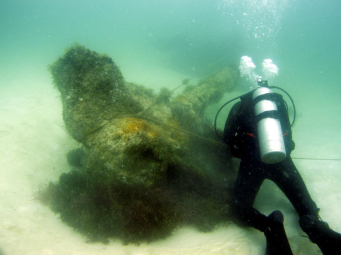
For Immediate Release
Friday, February 8, 2019
Contact: Sarah Revell
850.245.6522
[email protected]
Secretary of State Laurel M. Lee Announces the Designation of USS Narcissus Shipwreck Site on the National Register of Historic Places
Tallahassee, Fla. –
Secretary of State Laurel M. Lee announced today the USS Narcissus State Underwater Archaeological Preserve has been listed on the National Park Service’s National Register of Historic Places.
“The USS Narcissus participated in the blockading of southern ports and the Battle of Mobile Bay,” said Secretary Lee. “The shipwreck provides us with a tangible connection to the history of the American Civil War and the Department is thrilled that it is now listed on the National Register of Historic Places.”

The USS Narcissus State Underwater Archaeological Preserve, located northwest of Egmont Key, is the site of the wreck of a wooden-hulled steam tug boat that was lost in January 1866. The site includes the remains of the 82-foot-long tug and associated artifacts, including a four-bladed iron propeller, propeller shaft, skeg, keel, keel rider, sternposts, deadwood and a single cylinder inverted steam engine.
The USS Narcissus was built in 1863 and commissioned by the Navy the next year. It was assigned to the West Gulf Blockading Squadron, which was involved in preventing trade through Southern Gulf Coast ports. The ship served the Navy through the end of the war, including participating in the Battle of Mobile Bay in 1864. After the war ended, the USS Narcissus sailed to the East Coast to be sold in 1866 and sank in Tampa when the ship’s boiler exploded after she ran aground in a storm.
The USS Narcissus was rediscovered in the early 1980s by recreational divers and the site was looted. By the end of the decade, archaeological work at the site had begun and continued through 2015 when the site was declared Florida’s 12th Underwater Archaeological Preserve. A monument and bronze plaque were installed at the site.
The site has been adopted by the Friends of USS Narcissus, stakeholders from the local waterfront community who conduct periodic visits, clean the plaque, monitor the site and teach the importance of historic preservation and site stewardship. The wreck of the USS Narcissus continues to provide researchers and visitors insight into 19th century steam tugboats.
To learn more about Florida’s Underwater Archaeological Preserves, please visit museumsinthesea.com/.
# # #
About The National Register of Historic Places
The National Register of Historic Places is a list maintained by the National Park Service which includes historical or archaeological properties including buildings, structures, sites, objects, and districts, that are considered worthy of preservation because of their local, statewide and/or national significance. Nominations for properties in Florida are submitted to the National Park Service through the Florida Department of State’s Division of Historical Resources. Florida has over 1,700 listings on the National Register, including 295 historic districts and 175 archaeological sites. There are more than 50,000 sites contributing to the National Register in Florida. For more information, visit flheritage.com/preservation/national-register. For more information about the National Register of Historic Places program administered by the National Park Service, visit nps.gov/nr.
About The Florida Department of State’s Bureau of Historic Preservation
The Bureau of Historic Preservation (BHP) conducts historic preservation programs aimed at identifying, evaluating, preserving and interpreting the historic and cultural resources of the state. The Bureau manages the Florida Main Street Program, and under federal and state laws, oversees the National Register of Historic Places program for Florida, maintains an inventory of the state's historical resources in the Florida Master Site File, assists applicants in federal tax benefit and local government ad valorem tax relief programs for historic buildings, and reviews the impact that development projects may have on significant historic resources. For more information, visit flheritage.com/preservation.
